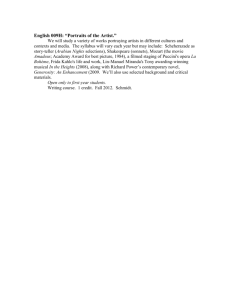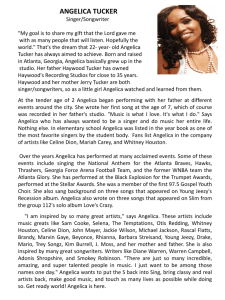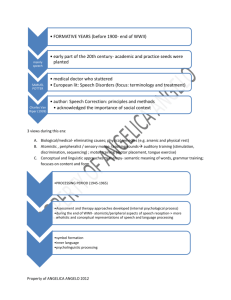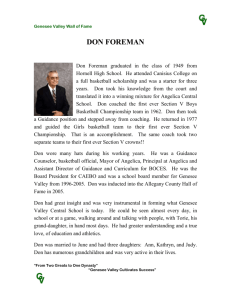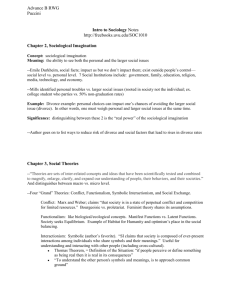SUOR ANGELICA A CREATIVE PROJECT SUBMITTED TO THE GRADUATE SCHOOL
advertisement
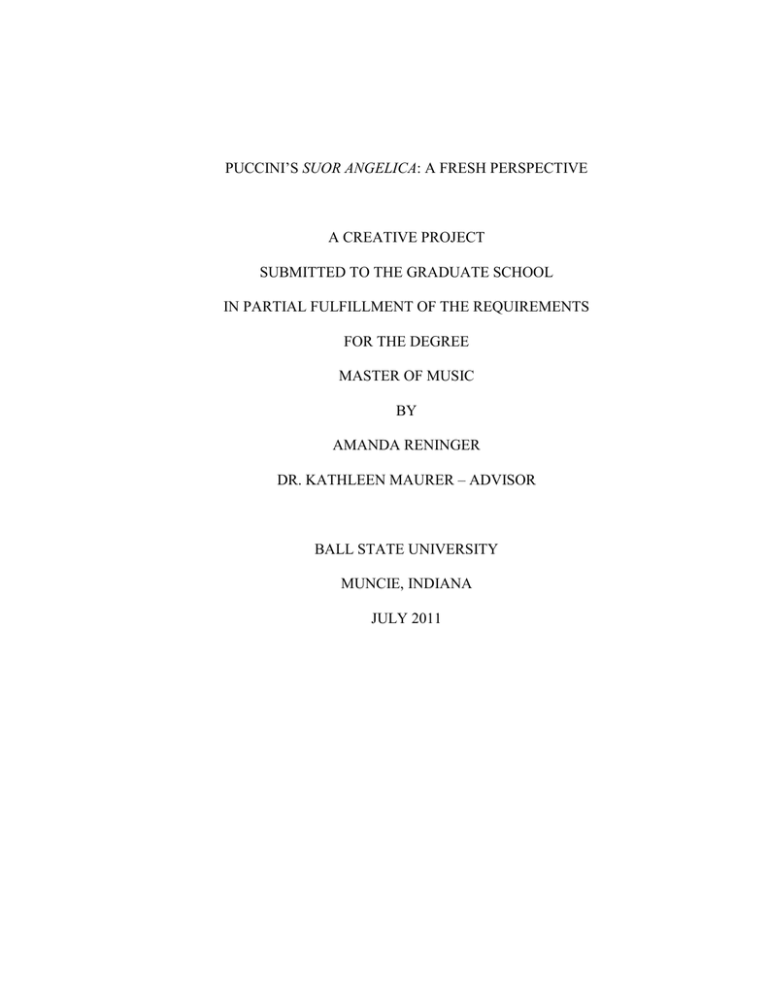
PUCCINI’S SUOR ANGELICA: A FRESH PERSPECTIVE A CREATIVE PROJECT SUBMITTED TO THE GRADUATE SCHOOL IN PARTIAL FULFILLMENT OF THE REQUIREMENTS FOR THE DEGREE MASTER OF MUSIC BY AMANDA RENINGER DR. KATHLEEN MAURER – ADVISOR BALL STATE UNIVERSITY MUNCIE, INDIANA JULY 2011 2 Puccini’s Suor Angelica: A Fresh Perspective Giacomo Puccini’s (1858-1924) Il trittico, a set of three one-act operas including Il tabarro, Suor Angelica, and Gianni Schicchi, received mixed reviews when it premiered at the Metropolitan Opera House on December 14, 1918, with Geraldine Farrar as Angelica. While most critics agreed Gianni Schicchi had the most potential of the three, Suor Angelica, with its all female cast, was soon dropped from the set and forgotten. If Il trittico is discussed as part of Puccini’s oeuvre, then Gianni Schicchi is likely the focus, and the only mention of Suor Angelica concerns the critiques of the opera. Over the years Suor Angelica has been described as ―lacking,‖ and is not usually considered to be one of Puccini’s most brilliant works.1 However, the lack of recognition the opera has received may be due to the societal issues surrounding its premiere in both America and Italy, and a misunderstanding of Puccini’s intentions for the piece. This study will focus on a number of different areas including Puccini’s reputation, the reception of Suor Angelica in both America and Italy, and the music and background of the opera. This essay will support the theory that Suor Angelica is musically equal to Puccini’s other operas, and that any negative response has been due to other issues such as sexism and a misinterpretation of the composer’s intentions, and not because of a lack of musical variety. I performed the title role of Sister Angelica in Ball State University’s production of Suor Angelica in November 2010. I was unfamiliar with the opera and was surprised to learn of the somewhat negative views that surrounded this work. As a young performer it 1 Jennifer Barnes, ―Where Are the Mothers in Opera?,‖ in Girls! Girls! Girls!: Essays on Women and Music, ed. Sarah Cooper (New York: New York University Press, 1996), 92. 3 is important to know the general critiques of any opera you perform, but it is also helpful to have a positive perspective. The intention of this project is to provide that positive perspective. In order to advance with this topic, there must first be an explanation of the story of Suor Angelica. The opera opens with scenes of normal convent activity, which include singing hymns, sisters getting scolded, and recreation. As the sisters are relaxing they discuss the fact that this day is the first of three that occur each year where the sun turns the water in their fountain golden. They decide to place this golden water on the tomb of a recently deceased sister, Bianca Rosa. Next, the topic turns to desires. As members of the convent, the sisters are to have no desires, but soon they each confess to their want for one thing or another. Sister Angelica is the only one to deny having any desires. The rest of the sisters immediately begin to whisper and gossip about Angelica saying she desires to hear from her noble family; she has had no contact with them for the past seven years. There are also rumors that she is in the convent as punishment. When the nursing sister runs to Angelica for help with a wasp sting we find out that she is an herbalist and often aids the sisters with medicinal remedies. Soon, two sisters return from a day of begging with food and supplies and news that a beautiful coach is waiting outside. Angelica becomes intrigued and asks about the coach. As she realizes to whom it belongs, she becomes visibly nervous. The Abbess enters and calls for Angelica to come meet with her visitor. The visitor is Angelica’s aunt, the Princess who despises Angelica. She is there to obtain Angelica’s signature, which will give her inheritance to her sister who is to be 4 married. Angelica can take it no longer and bursts out with questions about her illegitimate son who was born seven years ago. The Princess finally reveals that Angelica’s son died two years earlier from a terrible sickness. Angelica collapses in agony, signs the paper, and the Princess leaves. At this point Angelica sings her famous aria, ―Senza mamma,‖ and sees heavenly visions of her child. As she falls further into her delusions, she hears her son calling her to heaven to be with him. Angelica realizes what she must do and concocts a poison from her herbs and drinks it. Immediately she is full of guilt as she realizes she has committed the unforgiveable sin of suicide. She begins to beg the Virgin Mary for mercy, and soon dies with a vision of her son running to her to hug her. This vision implies that Angelica has been forgiven and will live with her son in heaven for eternity.2 Many of Puccini’s operas have been regarded as standard repertoire. They are valued for their beautiful music and dramatic story lines, as most well-loved operas are. However, it is difficult for a previously dismissed opera to become part of the standard repertory. It was not until the 1980s that anyone suggested that, perhaps, those who performed it had simply misunderstood Suor Angelica. In 1987 John DiGaetani made the argument that Puccini intended the setting of Suor Angelica to be similar to that of a seventeenth-century prison-like convent, instead of the nineteenth-century kitsch-convent that is typically reflected in the sets of modern performances.3 When the opera is set in the nineteenth century the audience does not understand why the convent is such a bad 2 Julian Budden, ―Suor Angelica,‖ The New Grove Dictionary of Opera, ed. Stanley Sadie, http://www.oxfordmusiconline.com/subscriber/article/grove/music/O904505 (accessed June 10, 2011). 3 John DiGaetani, Puccini the Thinker: The Composer’s Intellectual and Dramatic Development, 2nd ed. (New York: Peter Lang Publishing, 2001), 93-94. 5 place for Angelica to be. This immediately disconnects them from the character. However, if the seventeenth-century convent is portrayed, then the verismo aspect is brought in, allowing the audience to see why it would be an awful place to live, thus giving them an emotional connection to Angelica. The verismo movement began in literature, but expanded to the rest of the arts. The goal was to portray the realistic side of everyday life, no matter how uncomfortable it may be. It is clear from the above synopsis that Angelica is not comfortable in the convent, and neither are many of the other sisters. However, if the audience is seeing a well-lit, cheery convent, then it is understandable why they would not connect with the unhappy characters. The first thing the audience sees, especially if they are seated in a balcony, are the large sets, not the singers. This continuous misinterpretation of the setting of the opera is one reason why Suor Angelica has not been well received by audiences. In her book The Puccini Problem, Alexandra Wilson published the findings of her study of Puccini in relation to the nationalistic views of Italy during his lifetime. She connects the genre of opera to politics in general by showing that ―opera had long been a vehicle in Italy for the dissemination of nationalist messages to a wide audience.‖4 So, even though Puccini considered himself to be non-political, his work and politics became ―inextricably intertwined‖ because opera was ―most closely linked to the national selfimage,‖ and he was one of the most popular composers of the genre.5 4 Alexandra Wilson, The Puccini Problem: Opera, Nationalism and Modernity (Cambridge: Cambridge University Press, 2007), 3. 5 Ibid. 6 An understanding of the political issues during Puccini’s lifetime sheds light upon the reception of Il trittico at its premiere. In a short article in The Musical Times from 1919, Milne discusses how America anticipated a short war when World War I began in 1914 and that things had not turned out how most people had hoped. However, he goes on to explain that opera had become widely accepted during this time because of the influence of ―foreign and colonial friends.‖6 Milne also writes that American singers had greatly improved their operatic technique because of the previously stated influence. This information shows that opera as a whole was improving in this country and that any new performances should have been enthusiastically accepted. In a review of Il trittico from 1920, a New York Times critic described Suor Angelica as ―sending women weeping from the aisles.‖7 The critic also says that Rosa Raisa, who played Angelica, ―took the drab music and passive role, [and] deluged them with torrential sobs and some glorious singing.‖8 While this review is not cruel, the descriptions of women being overly emotional help to show that the public did not take women seriously because they were deemed too sensitive or fragile. It was not until August of 1920 that the nineteenth amendment was added to the constitution, giving American women the right to vote. Akhil Amar traces the history of women’s suffrage in America, following the progression from state to state. New York reluctantly gave women the right to vote in 1917, whereas only two years earlier it had 6 A. Milne, ―Music During the War,‖ The Musical Times 60, no. 911 (1919): 9. "Audience Thrilled By Puccini Triptich" New York Times, February 12, 1920, 9. 8 Ibid. 7 7 denied them that right.9 This demonstrates the attitude of the state of New York towards women’s suffrage a short time before the premiere of Il trittico in 1918. Other political issues in the United States include the opening of the first birthcontrol clinic in New York in 1916 by Margaret Sanger. The clinic was raided nine days later, and Sanger was arrested and sentenced to thirty days in jail. Sanger was not allowed to open a new clinic until 1923. This is yet another indication that the general public believed women were not intelligent enough to make their own decisions. While the political and cultural climate was changing in America, it had already begun to change in Italy. Women’s suffrage began there in the 1880’s, and by 1908 1,400 women attended a congress in Rome to fight for their rights. The author Alexandra Wilson discusses the political issues surrounding Puccini’s international reputation while giving the background on these same issues. She wittingly calls them ―The Puccini Problem.‖10 Wilson gives a clear depiction of ―the intensity of misogynist feeling that developed in Italy in the years preceding the First World War, and its close association with nationalist ambition.‖11 After the 1908 congress meeting many male critics responded with texts stating that the feminist movement would not infiltrate Italy. The thought was that, if feminism was mocked as a ―foreign import,‖ the energy behind it would quickly die away, and Italy would be safe. Many of these texts included the idea that it was a woman’s duty to be fully devoted to motherhood and nothing else. The 9 Akhil Amar, ―How Women Won the Vote,‖ The Wilson Quarterly 29, no. 3 (Summer 2005): 33. 10 Wilson, The Puccini Problem,147-148. 11 Ibid., 147. 8 people became even more fearful as the feminist movement caught on and the birth rate declined.12 Before 1908, the fear of a feminized Italy had saturated the fine arts. In 1894 Giovanni Segantini created a painting titled Le cattive madri (The Bad Mothers). The painting portrays ―a woman in a state of sexual ecstasy suspended in a tree, holding a dead or dying baby.‖13 The canvas was stating that a woman who selfishly refuses to partake in motherhood is also choosing not to fulfill her duty to others. Because it was shown at the second Milan Triennale, a gallery for the newest Italian art visited by politicians and royalty, it is clear that the government endorsed it.14 After the progression of women’s rights issues in Italy began, Fausto Torrefranca, an Italian nationalist and arts critic, harshly criticized Puccini in 1912. Wilson describes both the charges made against Puccini and the Italian political climate. Many young intellectuals in Italy were beginning an Italian nationalist movement at this time. Torrefranca was one of these individuals, and he chose to attack Puccini’s music because of his international popularity. Torrefranca said, ―Puccini’s music defames Italian culture abroad because it reveals an intellectual wretchedness.‖15 Torrefranca also attacked Puccini personally, stating that he was ignorant. He described Puccini as ―the little seamstress rather than the aristocratic lady, ignorant but content to be so.‖16 This association of Puccini with women came with damaging 12 Wilson, The Puccini Problem, 148-149. Ibid., 149. 14 Ibid., 149-150. 15 Alexandra Wilson, ―Torrefranca vs. Puccini: Embodying a Decadent Italy,‖ Cambridge Opera Journal 13, no. 1 (March 2001): 32. 16 Ibid., 35. 13 9 political implications because of the women’s suffrage issues during this time. Italy as a country feared becoming feminized, and Italians protected themselves by harshly criticizing women and anyone associated with them. Although most scholars consider Torrefranca’s claims to be extreme, they did have an effect on Puccini’s reputation. After Torrefranca’s critical opinions of Puccini were published, they were covered by major music and cultural journals distributed all over Italy. While some critics came to Puccini’s rescue, ―not one felt able to express wholehearted support for Puccini.‖17 This is because of Puccini’s tendency to choose strong women characters as the focus for his operas, something looked down upon in Italy at the time. Wilson also gives evidence concerning the reception of Suor Angelica in America, citing a review by James Huneker of the New York Times, who states Suor Angelica ―plays fifty minutes but seems double that time.‖18 This statement by Huneker was the general consensus in America about Suor Angelica. Wilson continues by making observations about the Italian premiere of this same opera. While some critics agreed that the piece was somewhat moving, most of them believed male voices should have been added. Neither of these statements is outright cruel towards women, but they do not praise the heroines either. It is my opinion that the argument for or against women’s rights had gone on for so long by the time the opera premiered that most people had become immune to it. This caused critics to treat pieces of art dealing with the subject, including Suor Angelica, with an offhand attitude instead of taking them seriously. 17 18 Wilson, ―Torrefranca vs. Puccini,‖ 52. Ibid., 178. 10 Wilson does a good job of stating the political side of things while also showing the artistic side of the premieres. It its through her work that one can see that the general dislike for Suor Angelica is directly related to the social and political climate surrounding the premiere. For years Puccini critics have described his women characters as ―suicidal or morally tainted.‖19 Mosco Carner, a Puccini scholar, wrote a critical biography on the composer. His discussion of Suor Angelica contains nothing particularly new, but it was originally written in 1958, before women’s studies had become popular. Carner describes the drama of Suor Angelica as suffering ―from an irremediable weakness, this is the sense of quietism and passivity inseparable from a cloistral atmosphere and therefore intrinsically un-dramatic.‖20 Carner continues by saying that the most inspired musical scenes are when Angelica and her Aunt interact and Angelica’s lament, ―Senza mamma.‖ He also notes that, ―the score bears signs of creative fatigue and sameness of tone, with melodic invention halting and often thin.‖21 This observation appears to be the typical response of Puccini experts. As Carner begins describing the relationship of the music and drama in Suor Angelica, he points out that many critics believe this opera is monotonous because of the absence of male voices, and that he believes this stance to be false. His reason for this is because ―Puccini’s treatment of the female voices is remarkably flexible and 19 Helen Greenwald, ―Verdi’s Patriarch and Puccini’s Matriarch: Through the LookingGlass and What Puccini Found There,‖ 19th-century Music 17, no. 3 (Spring 1994): 233. 20 Mosco Carner, Puccini: A Critical Biography, 3rd ed. (New York: Holmes and Meier Publishers, 1992), 487. 21 Ibid., 488. 11 individual.‖22 Carner also points out that Puccini calls for twelve out of the fifteen female characters to be mezzo-sopranos as opposed to sopranos, an uncommon requirement in opera. For example, the Princess, Angelica’s aunt, is a dramatic mezzo-soprano. This uncommon voice type typically has a very dark timbre and does not move very quickly from note to note as a coloratura voice would. Puccini uses these characteristics to create an intense and mean character. Musically, the aunt is set apart from the rest of the sisters because she often has an ascending line when she sings, going from very low pitches to much higher pitches in just a few measures with fairly slow and steady rhythms. This type of line grows with intensity as her anger towards Angelica escalates. Carner says Angelica’s lament shows three changes to her state of mind as portrayed through the accompanying music for the aria. The opening of the aria begins in a minor key and shows her anguish. The middle section, which shows her joy over visions of her child as an angel, is in a major key and is ―based on a hymn-like, longlimbed melody.‖23 The last section of the aria has a funereal rhythm and represents Angelica’s longing to die so that she can be with her child in heaven.24 In closing, Carner states that the only flaw in the aria is ―the lack of emotional and musical contrast in so extended an aria.‖25 He goes on to write that the reason this aria is not contrasting enough is because we hear this music in preceding scenes and again in the suicide scene, describing it as ―a sign of temporary fatigue in his [Puccini’s] creative powers.‖26 22 Carner, 489. Ibid., 492. 24 Ibid. 25 Ibid., 493. 26 Ibid. 23 12 While Carner makes valid points as to the issues in Suor Angelica, he does not seem to fully understand the mindset of Angelica’s character. For example, the listener may hear the same theme played multiple times before and after Angelica’s lament, but this underscores the fact that she is a mother whose mind is focused on one subjecther son. Therefore, Puccini was portraying Angelica’s focus on her son when he allowed the themes in her lament to be sounded again and again. These recurring motives also help to create compositional unity throughout the opera. Iris Arnesen released a 2009 study of all of Puccini’s operas and their relation to one another in her book The Romantic World of Puccini. This significant study suggests a completely new perspective on Puccini’s works. Arnesen suggests that Puccini’s operas are all connected into what she calls ―The Rose Cycle.‖ Throughout all of his operas there are recurring musical passages and themes. There are even recurring objects, such as the red rose. Although Puccini was often criticized for being too emotional and not intellectual enough, Arnesen says it was all intentional.27 Her discoveries help to show that although Puccini’s operas were emotional, they were not any less intellectual than those of his contemporaries. Arnesen defends Puccini’s works as a whole, and especially for Suor Angelica. She makes correlations between all of Puccini’s opera heroines and places each of his operas into a ―continuing and rather shocking story, one with a beginning, middle and an end that runs beneath the opera’s obvious surface plots.‖28 Arnesen also defends Puccini’s heroines by saying he was not portraying the evil in women, but was instead 27 Iris Arnesen, The Romantic World of Puccini: A New Critical Appraisal of the Operas (Jefferson, NC: McFarland & Company Publishers, 2009), 1-2. 28 Ibid., 13. 13 showing women as powerful by employing the typical objects used to describe women at this time, mainly the moon and flowers. For example, Suor Angelica takes place during a Catholic feast called quindena, which happens 15 days after Easter. Thus, the timing of the story is a celebration that is determined by the phase of the moon.29 This idea will be discussed further at a later place in this study. Also, as was stated earlier in the synopsis, Angelica was an herbalist and worked with flowers and various plants to create remedies for her and the rest of the sisters. Additionally, Angelica immediately turns to her flowers for help when she has decided that the only way to be with her son is to take her own life by drinking poison. Arnesen’s chapter on Suor Angelica connects the religious background with bridal mysticism, the cult of the Virgin Mary and maternal mysticism. Each of these terms refers to the idea that, in medieval times, the Church encouraged the worship of Mary as a superior woman. This led to the idealization of all women and their ability to produce children. Eventually, women’s rights became an important topic and those associated with religion hated that women were rejecting the traditional role of woman as mother. Arnesen analyzes Suor Angelica thoroughly and connects this opera to the bigger picture of what she refers to as ―The Rose Cycle,‖ thus providing proof that Puccini was certainly not fatigued, but instead was consistently inspired throughout all of his operas.30 She argues that each opera is the continuation of a story, except for Edgar and Gianni Schicchi. She explains, ―Le Villi is an introductory work. Il Tabarro is a related short 29 30 Arnesen, 35-36. Ibid., 242-255. 14 story. The remaining seven, full-length operas, and the one-act Suor Angelica, form the cycle itself.‖31 In terms of feminist research on opera, Suor Angelica should come to the forefront, as it is the only opera with an all-female cast. The casting alone makes it of interest to feminist researchers, but the connection between Sister Angelica and the Virgin Mary that Arnesen discusses makes this piece that much more appealing. Arnesen begins by discussing the relationship between Angelica’s son and the Virgin Mary’s son. She says the reason why the father of Angelica’s son is never mentioned has to do with Puccini creating the appearance of a virgin birth. Also, the name Mary means ―Queen of the Angels‖ and Angelica had been a princess, and her name literally means ―angel-like.‖32 Furthermore, Puccini often associated his heroines with the night sky and the moon, something he does with Angelica, and Mary is considered the ―Queen of Heaven.‖33 Puccini connects Angelica with the night sky and moon in her suicide, a climactic part of the opera. She drinks the poison under a night sky, and as she does this, the stage directions from Puccini indicate that the sky becomes dark as the clouds cover the moon and stars. This shows that Angelica’s character is directly related to the moon, sky, and stars.34 Lastly, Arnesen makes a strong correlation between the two women with the timing of the opera being at quindena. Arnesen suggests that Puccini was connecting the death of Angelica’s son to the death of Mary’s 31 Arnesen, 15. Ibid., 243-244. 33 Ibid., 244. 34 Ibid. 32 15 son. While this idea does not permeate the entire opera, it is there on purpose to evoke the idea of the death and resurrection of Mary’s son. Quindena is ―presided over by the Virgin Mary, who in medieval times became for Catholics the primary intercessor between mankind and God.‖35 In this opera, Mary is the one whom the nuns worship, she judges the lives of people, grants salvation, and resurrects the dead.36 This idolization of Mary, who in this case represents all women, was likely recognized by audiences in Italy, and would not have gone over well with a social climate still recovering from their misogynist views of women. Regarding the music of Suor Angelica, Spike Hughes describes the opening scenes as charming, and points out musical passages that give the listener clues as to what will happen later. Hughes also points out that Puccini, known for his representation of animals in music, handles the wasp scene beautifully. The wasp is ―characterized by piquant sounds from three muted trumpets and pizzicato figures from the strings.‖37 Later, Puccini employs the same creative style to portray a donkey and earlier, during Sister Genevieve’s aria, to depict sheep. One issue often stated by critics of Suor Angelica is the fact that it does not exhibit a variety of recurring themes and motifs. However, Angelica’s focus was on one thing, her child. This focus is verified by the use of a single idea over and over again. Puccini accomplishes this by using the music of the aria in various places throughout the opera. The first time we hear a major theme that will be repeated in the aria is during the 35 Arnesen, 244. Ibid. 37 Spike Hughes, Famous Puccini Operas: An Analytical Guide for the Opera-Goer and Armchair Listener, rev. 2nd ed. (1959; repr., London: Robert Hale Limited, New York: Dover Publications, 1972), 189. 36 16 chorus after Sister Osmina has been punished for carrying red roses in her robe. This section is loosely derived from the music that accompanies the words ―Now that you are an angel in heaven…‖ in Angelica’s lament. While the intervals are not exactly the same, the original chorus and the line from the lament share a similar movement pattern. The biggest difference is that the theme is slowed down in the lament. However, what is most interesting is this theme is last heard from the chorus in praise to Mary after Angelica is reunited with her son. In Figure one we see the chorus in three-part harmony, and in Figure two we see the line from the lament. Figure 1, Giacomo Puccini, Suor Angelica, rehearsal 6,mm. 13-15. Figure 2, Giacomo Puccini, Suor Angelica, ―Senza mamma,‖ rehearsal 61, mm. 1-2. 17 The next time Puccini gives the audience a bit of the lament is when Angelica is questioning one of the lay sisters about the coach outside. The melody in this section is the same as the music accompanying the words ―Through space eternal, I seem to hear thy passage.‖ The difference is that when Angelica is asking about the coach she is incredibly nervous. Therefore, the music moves much more quickly in rhythm. Figures three and four below show the questioning music and the music from the lament. Figure 3, Giacomo Puccini, Suor Angelica, rehearsal 36, mm. 8-13. 18 Figure 4, Giacomo Puccini, Suor Angelica, ―Senza mamma,‖ rehearsal 61, mm. 9-12. Moving forward in the story, we hear the lament in full with the words. In this context, it is a love song for her dead child, as well as a lament grieving her loss. After Angelica makes the decision to take her own life, she gathers some herbs and flowers to create a poison. It is during this action that we hear yet another variation of the lament. The accompaniment has a similar rhythm to one section of the aria, but a similar melody to another section of the aria. Puccini is combining different elements to achieve a new result. In Figures five and six we see two sections of the aria, and in Figure seven we see the music for the preparation of the poison, showing the combined rhythmic and melodic elements from both. 19 Figure 5, Giacomo Puccini, Suor Angelica, ―Senza mamma,‖ rehearsal 62, mm. 1-3. Figure 6, Giacomo Puccini, Suor Angelica, rehearsal 61,mm. 17-20. 20 Figure 7, Giacomo Puccini, Suor Angelica, rehearsal 69, mm. 1-12. 21 Each of the above melodies is derived from some part of Angelica’s aria. It is easy to hear them and wonder what Puccini was thinking, because they are used frequently. However, when we understand that he was portraying Angelica’s state of mind from the beginning, it opens up a whole new way of listening to the opera, and it shows that this work was in no way lacking in musical creativity. The orchestration used by Puccini in Suor Angelica also contains his own exceptional stamp. He requires a large number of instruments for a relatively small cast of singers, but he uses them in creative ways. On stage the orchestra consists of triple woodwinds, four horns, three trumpets, four trombones, a harp, timpani, triangle, celesta, and glockenspiel. Off stage he adds an organ, a piccolo, three trombones, bronze and steel bells, cymbals, and two pianos. This smaller orchestra is used in the final scene, ―The Miracle.‖ While strings often accompany the vocal parts, the other instruments are used to add character to the whole of the music. This idea of using instruments for their timbre in relation to specific ideas throughout the opera was also a feature of Puccini’s technique. Lastly, there is a question of whether Angelica’s lament, ―Senza mamma,‖ is fantastic enough to raise Suor Angelica to the status of a great opera. The aria does not contain the type of impressive coloratura lines that many opera listeners like to hear; this is because the role of Angelica was composed for a true lyric soprano. However, the vocal phrases in this aria are as difficult as any of Puccini’s other arias. For example, the sheer length of the aria is difficult enough, being seven pages marked lento grave, but it also spans a range of an octave and a half ending on a high A-natural marked pianissimo. However, what sets this aria apart is the pure emotion in the text and the atmosphere in 22 which it is sung. Angelica has just lost the only person she has ever loved, and her mood must change from anguished to ecstatic to suicidal all within a matter of minutes, a difficult feat for the singer and actor. A thorough study of the music in Puccini’s Suor Angelica has shown that Puccini gave as much of himself to this opera as to any of his other works. The surrounding issues of sexism, politics, staging, and music of Suor Angelica explain the somewhat negative reception at the premieres. However, the fact that Suor Angelica is often performed today shows that it has won a permanent place in the standard repertory. 23 Bibliography Amar, Akhil. ―How Women Won the Vote.‖ The Wilson Quarterly 29, no. 3 (Summer 2005): 30-34. "Audience Thrilled By Puccini Triptich." New York Times, February 12, 1920, 9. Arnesen, Iris. The Romantic World of Puccini: A New Critical Appraisal of the Operas. Jefferson, NC: McFarland & Company, Inc., 2009. Barnes, Jennifer. ―Where Are the Mothers in Opera?‖ In Girls! Girls! Girls!: Essays on Women and Music, edited by Sarah Cooper, 86-97. New York: New York University Press, 1996. Budden, Julian. "Suor Angelica." In The New Grove Dictionary of Opera, edited by Stanley Sadie. Grove Music Online. Oxford Music Online, http://www.oxfordmusiconline.com/subscriber/article/grove/music/O904505 (accessed June 21, 2010). Carner, Mosco. Puccini: A Critical Biography. 3rd ed. New York: Holmes & Meier Publishers, Inc., 1992. DiGaetani, John. Puccini the Thinker: The Composer’s Intellectual and Dramatic Development. 2nd ed. New York: Peter Lang Publishing, Inc., 2001. Greenwald, Helen. ―Verdi’s Patriarch and Puccini’s Matriarch: Through the LookingGlass and What Puccini Found There.‖ 19th-century Music 17, no. 3 (Spring 1994): 220-236. Hughes, Spike. Famous Puccini Operas: An Analytical Guide for the Opera Goer and Armchair Listener. Rev. 2nd ed. London: Robert Hale Limited, 1959. Reprint, New York: Dover Publications, Inc., 1972. Milne, A. ―Music During the War.‖ The Musical Times 60, no. 911 (1919): 9. Wilson, Alexandra. The Puccini Problem: Opera, Nationalism and Modernity. Cambridge: Cambridge University Press, 2007. ———. ―Torrefranca vs. Puccini: Embodying a Decadent Italy.‖ Cambridge Opera Journal 13, no. 1 (March 2001): 29-53.
